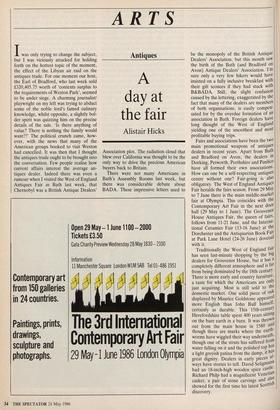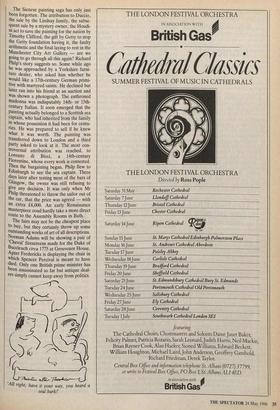ARTS
Iwas only trying to change the subject, but I was viciously attacked for holding forth on the hottest topic of the moment, the effect of the Libyan air raid on the antiques trade. For one moment our host, the Earl of Bradford, who last week sold £320,405.75 worth of 'contents surplus to the requirements of Weston Park', seemed to be under siege. A charming journalist/ playwright on my left was trying to abduct some of the noble lord's famed culinary knowledge, whilst opposite, a slightly bol- der spirit was quizzing him on the precise details of the sale. 'Is there anything of value? There is nothing the family would want?!' The political crunch came, how- ever, with the news that many of the American groups booked to visit Weston had cancelled. It was then that I thought the antiques trade ought to be brought into the conversation. Few people realise how current affairs interest the average an- tiques dealer. Indeed there was even a rumour when I visited the West of England Antiques Fair in Bath last week, that Chernobyl was a British Antique Dealers'
Antiques
A day at the fair
Alistair Hicks
Association plot. The radiation cloud that blew over California was thought to be the only way to drive the precious American buyers back to Britain.
There were not many Americans in Bath's Assembly Rooms last week, but there was considerable debate about BADA. These impressive letters used to be the monopoly of the British Antique Dealers' Association, but this month saw the birth of the Bath (and Bradford on Avon) Antique Dealers' Association. I'm sure only a very few hikers would have insisted on a fully inclusive breakfast with their gilt sconces if they had stuck with B&BADA. Still, the slight confusion caused by the lettering, exaggerated by the fact that many of the dealers are members of both organisations, is easily compen- sated for by the overdue formation of an association in Bath. Foreign dealers have long thought of the West of England yielding one of the smoothest and most profitable buying trips. Fairs and associations have been the two main promotional weapons of antiques dealers in recent years. Apart from Bath and Bradford on Avon, the dealers in Dorking, Petworth, Perthshire and Pimlico have all formed their own associations. How can one be a self-respecting antiques centre without one? Fair-going is also obligatory. The West of England Antiques Fair heralds the fairs season. From 29 May to 7 June there is the main middle-market fair at Olympia. This coincides with the Contemporary Art Fair in the next door hall (29 May to 1 June). The Grosvenor House Antiques Fair, the queen of fairs, follows from 11-21 June, and the Interna- tional Ceramics Fair (13-16 June) at the Dorchester and the Antiquarian Book Fair at Park Lane Hotel (24-26 June) dovetail with it.
Traditionally the West of England fair has seen last-minute shopping by the big dealers for Grosvenor House, but it has a completely different atmosphere and is far from being dominated by the 18th century. There is more early and country furniture, a taste for which the Americans are only just acquiring. Most is still sold to the domestic market. One solid piece of oak displayed by Maurice Goldstone appeared more English than John Bull himself' certainly as durable. This 15th-century Herefordshire table spent 400 years sitting on the bare earth in a barn. It was thrown out from the main house in 1580 and though there are marks where the earth- worms have wiggled their way underneath, though one of the struts has suffered from water falling on it and the polished top has a light greyish patina from the damp, it has great dignity. Dealers in early pieces al- ways have stories to tell. David Seligman° had an 18-inch-high wooden spice castle. Richard Philp had a magnificent Venetia!' casket, a pair of stone carvings and a!s° showed for the first time his latest Scottish discovery.
The Sienese painting saga has only just been forgotten. The attribution to Duccio, the sale by the Lindsay family, the subse- quent sale by a mystery owner, the Houdi- ni act to save the painting for the nation by Timothy Clifford, the gift by Getty to stop the Getty foundation having it, the faulty arithmetic and the final laying to rest in the Manchester City Art Gallery — are we going to go through all this again? Richard Philp's story suggests so. Some while ago he was approached by a Yorkshire furni- ture dealer, who asked him whether he would like a 17th-century German primi- tive with martyred saints. He declined but later ran into his friend at an auction and was shown a photograph. The enthroned madonna was indisputably 14th- or 15th- century Italian. It soon emerged that the painting actually belonged to a Scottish sea captain, who had inherited from the family in whose possession it had been for centu- ries. He was prepared to sell if he knew what it was worth. The painting was transferred down to London and a third party asked to look at it. The most con- troversial attribution was reached, to Lorenzo di Bicci, a 14th-century Florentine, whose every work is contested. Then the bargaining began. Philp flew to Edinburgh to see the sea captain. Three days later after testing most of the bars of Glasgow, the owner was still refusing to give any decision. It was only when Mr Philp threatened to throw the sailor out of the car, that the price was agreed — with an extra £4,000. An early Renaissance masterpiece coud hardly take a more direct route to the Assembly Rooms in Bath. The fairs may not be the cheapest place to buy, but they certainly throw up some outstanding works of art of all descriptions. Norman Adams will be showing a pair of Cheval' firescreens made for the Duke of Buccleuch circa 1775 at Grosvenor House. Apter Fredericks is displaying the chair in which Spencer Percival is meant to have died. Only one British prime minister has been assassinated so far but antique deal- ers simply cannot keep away from politics.















































 Previous page
Previous page